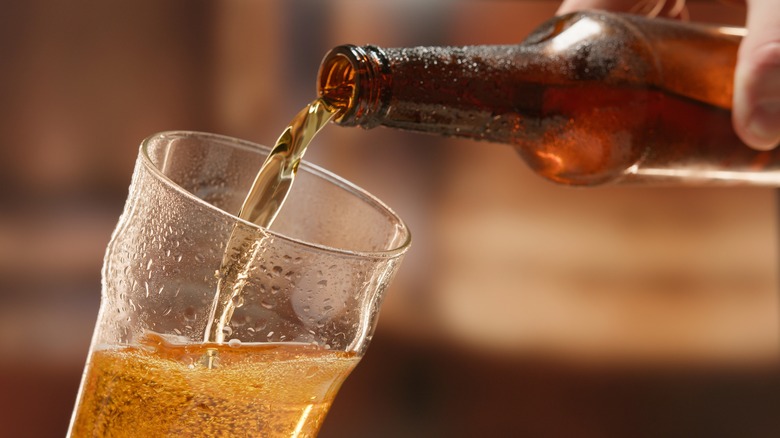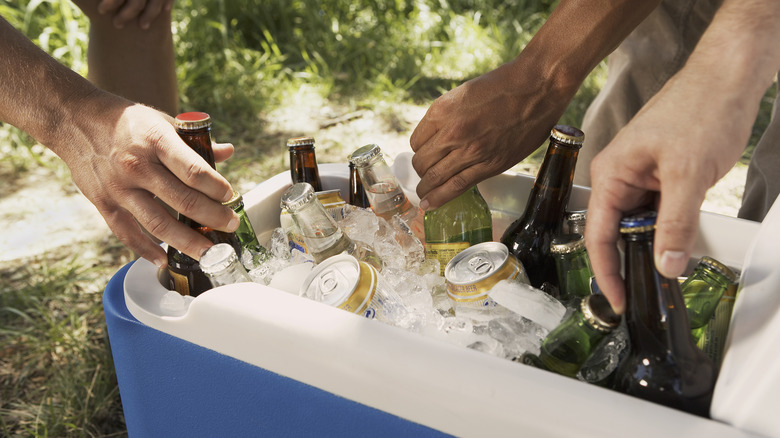What Is The 3-30-300 Rule For Beer?
Not to be confused with the green space rule created by urban forester Cecil Konijnendijk, the 3-30-300 rule has become a guiding principle for many in the beer industry. Many breweries cite the guidelines as a way to simplify beer storage, but what exactly is the 3-30-300 rule? It's all to do with the duration of time and the temperature at which the beer is stored. Beer will experience the same oxidation across a three-day, 30-day, and 300-day interval when stored at different temperatures.
According to the 3-30-300 rule, if you store your beer at 90 degrees Fahrenheit, it will only maintain its quality for three days. So, if you left your beer in a hot car all day then don't fret, it's probably still good. However, you shouldn't make a habit of it as you'll notice a drop in quality after 36 hours. Comparatively, you can store your beer at room temperature for nearly a month before noticing the same decrease in taste and aroma. Beer stored at 72 degrees Fahrenheit will lose its flavor after 30 days. If you want to maximize how long you can store your beer, then you will want to drop the thermostat. Beer stored at 38 degrees Fahrenheit will last for 300 days comparatively. The Miller Brewing Company established the rule to simplify beer storage and also show how important it is to keep your beer in a cold location. However, the 3-30-300 rule doesn't account for everything.
Other things to consider
The 3-30-300 rule is a simplification of beer storage that doesn't account for other variables. For instance, you should also consider when a beer is bottled as well. The same brand of beer bought at the store could age differently if one bottle was brewed earlier than the next. Take a look at the brew date on the bottle. Likewise, the type of beer as well as the brand of beer plays a role in how fast it ages. Depending on what ingredients it's made with, a beer can ruin either slower or quicker than the rule states. Likewise, the rule doesn't account for fluctuations in the temperature, which may not affect a beer short-term but can significantly age it long-term.
However, many turn to the 3-30-300 rule as a general guideline. It's worth noting that beer cannot go bad from a traditional sense. "Pathogens cannot live in beer, so from a health standpoint, beer cannot go bad," Firestone Walker Sensory Research Analyst Craig Thomas explained. However, a beer loses its aroma and taste as it ages and oxidizes, taking on a cardboard-like taste. High temperatures will increase the rate at which a beer oxidizes, thus shortening the lifespan of your drink. You may be tempted to toss your beer in the freezer to maximize how long your beer keeps, but that can affect how it tastes as well as potentially cause your beer bottles to shatter. Instead, consider following proper guidelines to store your beer.
How to properly store your beer
Ideally, the best place to store your beer is in a dark, cool place with a stable temperature. You should avoid placing your beer in direct light, as it can also affect the lifespan of your beer as well. Generally, the best temperature to store your beer at is somewhere between 45 to 55 degrees Fahrenheit. This will reduce the rate of oxidation that befalls beer stored at higher temps. Likewise, you won't have to worry about the coldness of the beer numbing your taste buds as you would at lower temperatures. All of the flavors will be on display when stored at the optimal temp.
If you have a cellar, you can certainly store your beer alongside your wine. However, before you go making renovations to your house, know you can put them in the fridge. It's best to have a separate fridge for your beer where you can dial-in on the temperatures needed for your beer without worrying about ruining your food. While the above temperatures are optimal, you should also consider what kind of beer you have. For instance, wheat beers and pilsners generally store well at 40 to 50 degrees since they're lighter beer that benefits from the colder temp. Comparatively, store high-alcohol beers such as stouts or barley wines at a higher temperature, somewhere between 55 to 60 degrees. They're designed to withstand a higher climate. When in doubt, remember the 3-30-300 rule.


